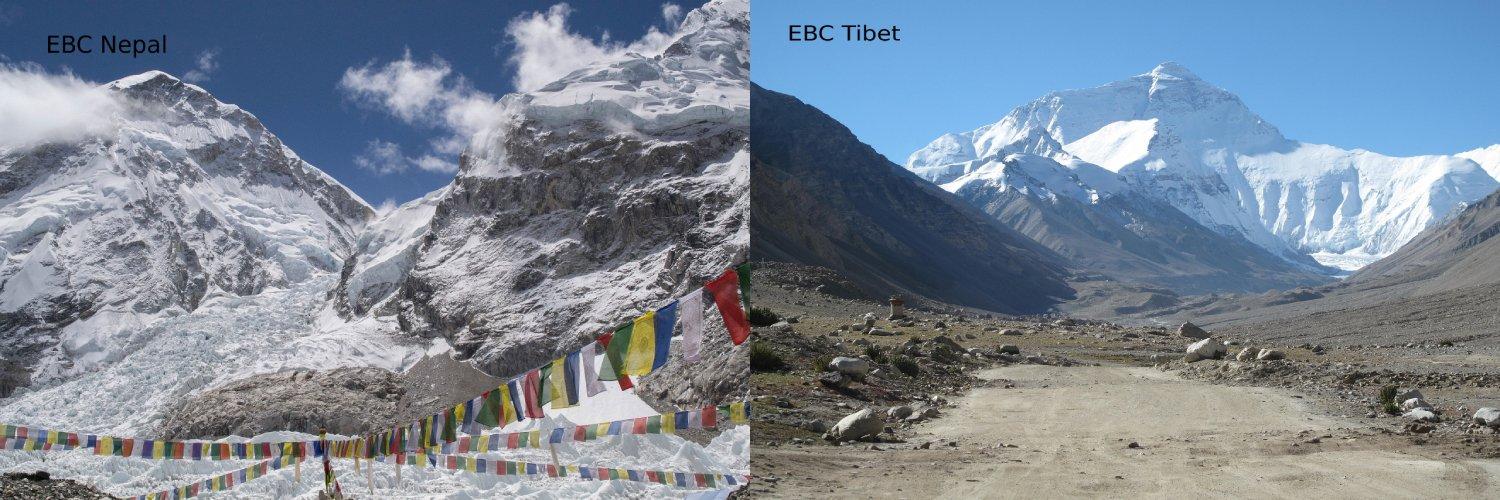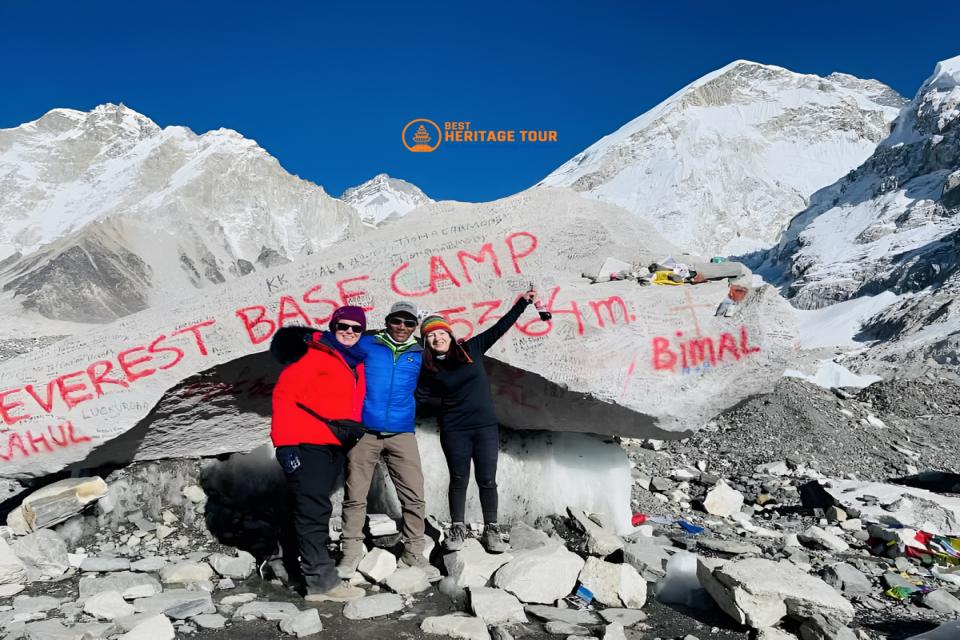Everest Base Camp (EBC) is the dream destination for trekkers and adventure travelers worldwide. While the Nepal route has been the traditional choice for decades, the Tibet route is becoming increasingly popular due to its unique perspective and relatively easier trekking conditions.
Many travelers ask: Which route is easier, and which one is better suited for my fitness and travel style? This comprehensive guide explores all aspects, including distance, altitude, terrain, logistics, accommodation, cultural experiences, and costs, helping you make an informed decision. Additionally, it highlights why booking with Best Heritage Tour guarantees a safe, seamless, and unforgettable journey.
Overview of the Routes
EBC from Nepal
The Nepal route to Everest Base Camp is known for its classic trekking experience and breathtaking Himalayan scenery. The trek starts from Lukla, a small mountain town accessible via a thrilling flight from Kathmandu. Key highlights along the route include:
-
Namche Bazaar: Often called the gateway to the high Himalayas, Namche Bazaar is a bustling Sherpa town offering markets, local cuisine, and acclimatization opportunities.
-
Tengboche: Known for its famous monastery and sweeping Himalayan views, this village is a spiritual and scenic highlight.
-
Dingboche & Lobuche: High-altitude trekking hubs where travelers rest and acclimatize, crucial for safe progression.
-
Everest Base Camp (Nepal Side): At 5,364 meters, EBC offers stunning views of Everest’s south face and Khumbu Icefall, as well as an unforgettable sense of achievement after days of trekking.
The Nepal route is 100% on foot, requiring 12-14 days, depending on acclimatization stops and pace. The physical effort, combined with cultural exposure in Sherpa villages, makes this route a truly immersive Himalayan adventure.
EBC from Tibet
The Tibet route offers a distinct experience with a combination of driving and short treks. Most travelers begin in Lhasa, Tibet’s capital, and visit several key stops:
-
Shigatse: Tibet’s second-largest city, home to Tashilhunpo Monastery, offering a glimpse of Tibetan life and culture.
-
Rongbuk Monastery: The highest monastery in the world, located close to Everest Base Camp (Tibet side), with panoramic views of Everest’s north face.
-
Everest Base Camp (Tibet Side): At 5,150 meters, this EBC is less crowded than the Nepal side, providing a more serene and meditative experience.
Since most of the Tibet route is traveled by vehicle, the trekking segments are shorter and less physically demanding, making it suitable for travelers with moderate fitness or limited time.
Comparing Distance and Duration
|
Route |
Distance (approx.) |
Duration |
Notes |
|---|---|---|---|
|
Nepal EBC |
130 km |
12-14 days |
Entirely on foot; multiple acclimatization stops provide gradual altitude adjustment. |
|
Tibet EBC |
120-130 km |
7-9 days |
Mostly traveled by vehicle; trekking sections are short, less physically demanding. |
Observation: The Tibet EBC route is less physically challenging because travelers rely on vehicles for long stretches. In contrast, Nepal EBC offers classic trekking immersion, with multiple days of walking at high altitudes.
Altitude and Acclimatization
Altitude is the most significant challenge on both routes, requiring careful planning.
Nepal EBC
-
Highest point: 5,364 meters
-
Trekking involves gradual ascents through Namche, Tengboche, and Dingboche, giving trekkers time to acclimatize.
-
Requires good fitness, stamina, and experience with high-altitude trekking.
-
Travelers may experience mild to moderate altitude sickness, so pacing and hydration are essential.
Tibet EBC
-
Highest point: 5,150 meters
-
Most of the route is covered by comfortable vehicle rides, with shorter treks to EBC and surrounding viewpoints.
-
Acclimatization occurs at Shigatse and Rongbuk, making it manageable for most travelers.
Conclusion: Tibet EBC is easier regarding altitude exposure, while Nepal EBC is more challenging but offers the classic trekking experience and sense of achievement.
Terrain and Trekking Difficulty
Nepal Route:
-
Trails are rugged, rocky, and occasionally steep, with river crossings and narrow passes.
-
Trekkers walk 5-7 hours daily, demanding good endurance and mental resilience.
-
Requires sturdy trekking boots, trekking poles, and experience on uneven terrain.
Tibet Route:
-
Most of the route is paved or motorable roads, with short trekking segments to EBC and viewpoints.
-
Daily walking is minimal (1-3 hours at most), ideal for travelers seeking a lighter physical challenge.
-
Suitable for families, older travelers, and first-time Everest visitors.
Observation: Tibet EBC is less physically intense, whereas Nepal EBC is ideal for those seeking true trekking adventure and personal accomplishment.
Cultural Experience
Nepal EBC
-
Immersion in Sherpa culture, Buddhist monasteries, and Himalayan villages.
-
Travelers experience local tea houses, traditional foods, festivals, and rituals.
-
Interaction with locals provides a human-scale cultural experience, offering insight into mountain life.
Tibet EBC
-
Focused on Tibetan Buddhist culture, monasteries, prayer flags, and pilgrimage towns.
-
Visitors witness monks’ rituals, religious ceremonies, and authentic Tibetan spiritual practices.
-
Key sites include Potala Palace, Jokhang Temple, Tashilhunpo Monastery, and Rongbuk Monastery near Everest.
Observation: Nepal EBC is rich in local village interactions, whereas Tibet EBC emphasizes majestic religious landmarks and spiritual immersion.
Accommodation and Facilities
|
Route |
Accommodation |
Notes |
|---|---|---|
|
Nepal EBC |
Tea houses, lodges, guesthouses |
Limited amenities at higher altitudes; shared rooms common. |
|
Tibet EBC |
Hotels, lodges, monastery guesthouses |
More comfortable, hygienic, and organized accommodations; suitable for travelers preferring convenience. |
Conclusion: Tibet route is more comfortable and convenient, while Nepal EBC offers rustic, authentic trekking lodges appealing to adventurers.
Cost Comparison
-
Nepal EBC: Budget-friendly options, though trekking involves multiple nights in lodges, food costs, and permits.
-
Tibet EBC: Slightly higher cost due to permits, guided tours, and transportation, but reduces the physical effort required.
Observation: Tibet EBC is easier physically but may be costlier, whereas Nepal EBC is affordable but more challenging.
Fitness Requirements
-
Nepal EBC: Requires good endurance, high-altitude trekking experience, and mental resilience.
-
Tibet EBC: Moderate fitness is sufficient; suitable for travelers with limited trekking experience.
Tip: Both routes require preparation for high-altitude conditions, hydration, and layered clothing.
Scenic Views
-
Nepal Route: Offers close-up views of Everest’s south face, Khumbu Icefall, glaciers, and Himalayan villages.
-
Tibet Route: Offers majestic north face views, wide open Tibetan plateaus, glaciers, and less crowded landscapes.
Both routes provide epic photographic opportunities, but the perspectives differ: Nepal is intimate and immersive, Tibet is grand and expansive.
Why Travel With Best Heritage Tour
Booking with Best Heritage Tour ensures:
-
Complete permits, transport, and accommodations for both Nepal and Tibet EBC.
-
Experienced guides for trekking safety, cultural insights, and local support.
-
Tailored itineraries for fitness level, time, and interests.
-
Smooth logistics, especially for Tibet, where independent travel is restricted.
Conclusion: Whether you choose Nepal or Tibet, Best Heritage Tour guarantees a safe, comfortable, and memorable EBC experience.
Final Comparison: Which One is Easier?
|
Feature |
Nepal EBC |
Tibet EBC |
|---|---|---|
|
Physical Challenge |
Moderate to High |
Low to Moderate |
|
Duration |
12-14 days |
7-9 days |
|
Altitude Exposure |
Higher |
Slightly lower |
|
Accommodation |
Tea houses, basic |
Hotels, lodges, monastery guesthouses |
|
Cultural Immersion |
Sherpa villages, local festivals |
Tibetan monasteries, pilgrimage sites |
|
Cost |
Moderate |
Slightly higher |
Summary:
-
Easier physically: Tibet EBC
-
More authentic trekking experience: Nepal EBC
-
Comfort & convenience: Tibet EBC
-
Cultural and adventure immersion: Nepal EBC
Your choice depends on time, fitness, and personal preferences.
Conclusion
Both routes to Everest Base Camp are life-changing experiences, offering majestic Himalayan landscapes, spiritual encounters, and rich cultural immersion.
-
Choose Nepal EBC for a classic trekking adventure with Sherpa culture and mountain village life.
-
Choose Tibet EBC for less physically demanding trekking, easier logistics, and unique Tibetan cultural exposure.
Booking with Best Heritage Tour ensures that whichever route you choose, your Everest adventure is safe, well-guided, and unforgettable.
Book Your Everest Base Camp Trek Today
Phone: +977-9851149197 / +977-9810043046
Email: info@bestheritagetour.com / bestheritagetour@gmail.com
Website: www.bestheritagetour.com
Office: Thamel Marg, Kathmandu, Nepal
Author: Best Heritage Tour
Date: 25th August, 2025



